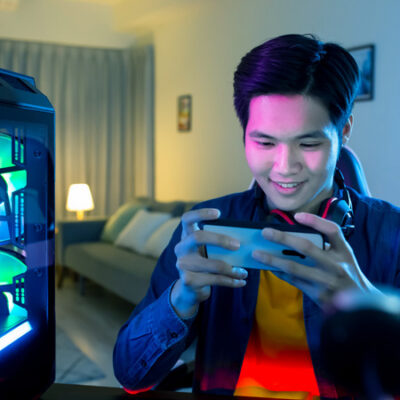As the pandemic continues to affect restrictions on movement and
in-person interactions, Filipino adolescents today have a starkly distinctive experience of going online. Screens have become crucial in the conduct of one’s affairs, and internet use has skyrocketed. In fact, a recent survey reports that the average Filipino teen spends about 10 hours per day online via various devices compared to around 6 hours per week in 2014 (Statista Research Department, 2022).
This is a cause for concern as more screen time opens up the possibility of problematic internet use (PIU), otherwise known as compulsive internet use or internet addiction. PIU was already a growing area of interest by clinicians pre-pandemic, as a review of studies in 31 countries states that about 6% of adolescents already engage in PIU (Cheng and Li, 2014). It continues to be a problem amid the pandemic as in a study comparing internet use during
lockdown among young people in low to middle-income countries, respondents from the Philippines have significantly high scores in measures of problematic internet use, social media use, and general app usage (Fernandes et al., 2021).
Teens are said to be addicted to the internet when there is an inability to control thoughts and behaviors over going online that significantly cause impairment in functioning. Other indicators include a preference for online rather than face-to face-relationships and turning to the internet to relieve negative mood states such as stress, sadness, or anxiety (Gámez-Guadix et al., 2012).
The last indicator helps us understand why young people’s internet use is important to look out for, despite the ubiquity of screens nowadays. As social distancing measures continue to harbor feelings of isolation and loneliness in adolescents (Fegert et al., 2020), they likely fall into various activities such as using the internet to escape and cope (Yao and Zhong, 2014). The internet provides relief through small doses of dopamine for every notification, message, interesting story, or video (Liu and Luo, 2015). However, when we don’t monitor how it may take a hold in our lives, internet use may lead to more negative physical and emotional health outcomes, and the vicious cycle repeats.
Can Mindfulness Help?
Mindfulness has gained popularity in the past decade and has been increasingly incorporated into psychological interventions for children and adolescents. Evidence points to the many benefits of mindfulness training, including the reduction and prevention of stress, symptoms of depression and anxiety and behavioral problems for this specific population (e.g., Britton et al., 2014; Raes et al., 2014; Singh et al., 2007 as cited in Gámez-Guadix & Calvete, 2016).
Mindfulness refers to the ability to become fully present and aware of one’s sensations (what we see, smell, hear, taste, or feel), thoughts (e.g., “I am not good at this”), and emotions (e.g., “I feel really bad”), and turning towards them with curiosity and nonjudgment (Kabat-Zinn,
2003).
Through mindful awareness, teens can learn to befriend and ride the wave of negative emotions, realize that feelings of sadness, anxiety, stress, etc., come and go, and practice detachment. They can also begin to make thoughtful decisions in dealing with their distress
rather than automatically reacting or giving in to their impulses, and perhaps start using the internet with more intention (Gámez-Guadix & Calvete, 2016).
The Cellphone Observation Exercise
The good news is that information on mindfulness is accessible and there is a plethora of resources available to help teens get started on their practice. To get a teen to specifically notice internal reactions while using their devices and think of changes they might make in terms of their relationship with them, the exercise below, adapted from David M. Levy, may prove useful.
It can be done alone as well as with an older sibling or parent, to better facilitate reflection. Each step begins with a prompt to do something in relation to one’s phone or device. One is also asked to note how their mind and body are reacting while performing the steps. A piece of paper may be necessary to write down a few words or phrases.
- Think about your phone or device without holding or using it. What do you experience (what comes up in your mind and body) when you think about your phone or device?
- Take out your phone and hold it in your hand or go near your device without turning on the screen. Again, pause here to notice how you feel. Is there a pull to do something in particular. What does that feel like in your body? What does it feel like to pause for a moment and wait?
- Turn on your phone or device and proceed to open an app of your choosing. Look at the interface in general and do not engage with the app right away. What was the experience like for you?
- Engage in the app – perhaps read a post or send a message or two. What happens in your mind and body as you do this?
- Finally, stash your phone in your pocket, bag, or drawer, or move a few feet away from your device. How did you feel as you did this?
Post Exercise Reflection:
Look back on the experience and notes written if there are any. Was any of your reactions in a particular step noteworthy? What might this suggest about your relationship with your phone or device? Does it suggest any changes you might need to make?
Mindfulness Practices and the Use of Technology
There are other ways mindfulness can be woven into a teen’s routine that may help address issues with internet use. The following are found below.
1. Mindfully setting and sticking to schedule
Setting specific hours for waking, eating, and sleeping, and committing to it will already make a huge difference in lessening opportunities to engage in nonproductive internet use.
2. Use a mindfulness bell and practice S.T.O.P.
Apps such as The Awakening Bell or The Bell of Mindfulness help recreate the experience of meditation bells in Buddhist temples by ringing a bell or gong sound through your phone or device’s speakers for every time interval specified. Use this as a reminder to bring your mind back to the present moment and then practice S. T. O. P., which stands for:
Stop. Whatever you are doing, pause momentarily.
Take a breath. Re-connect with your breath to anchor in the present moment.
Observe. What is happening inside you, and outside of you? What do you feel? What are you doing?
Proceed. Continue with what you are doing. Or not, depending on the information gathered during the exercise.
The more you STOP during the day, the more you could possibly be aware of your intentions behind every swipe or click thus preventing from going on autopilot.
It is important to keep in mind that it may take some time before mindfulness becomes a habit for anyone, let alone a teen. It is a skill that needs practicing. Many people become frustrated when their mind wanders or forget to apply the mindfulness skills above as there is pressure to get things “right or correctly” the first time. As long as one notices wandering to return and observe the present moment, one is already doing mindfulness.
Resources:
• https://www.humanetech.com/
• https://www.youtube.com/c/headspace
• https://mindful.org
• https://self-compassion.org/
Work Cited:
Cheng, C., & Li, A. Y. (2014). Internet addiction prevalence and quality of (real) life: A meta-analysis of 31 nations across seven world regions. Cyberpsychology, Behavior and Social Networking, 17, 755– 760. https://doi.org/10.1089/cyber.2014.0317
Fegert, J. M., Vitiello, B., Plener, P. L., & Clemens, V. (2020). Challenges and burden of the
Coronavirus 2019 (COVID-19) pandemic for child and adolescent mental health: a narrative
review to highlight clinical and research needs in the acute phase and the long return to
normality. Child and Adolescent Psychiatry and Mental Health, 14, 20. https://doi.org/10.1186/s13034- 020-00329-3
Fernandes, B., Uzun, B., Aydin, C., Tan-Mansukhani, R., Vallejo, A., Saldaña-Gutierrez, A., Biswas, U. N., & Essau, C. A. (2021). Internet use during COVID-19 lockdown among young people in low- and middle-income countries: Role of psychological well-being. https://doi.org/10.1016/j.abrep.2021.100379
Gámez-Guadix, M., Villa-Gorge, F. I., & Calvete, E. (2012). Measurement and analysis of the cognitive-behavioral model of generalized problematic internet use among Mexican adolescents. Journal of Adolescence, 35(6), 1581-1591. https://doi.org/10.1016/j.adolescence.2012.06.00
Gámez-Guadix, M., & Calvete, E. (2016). Assessing the Relationship between Mindful Awareness and Problematic Internet Use Among Adolescents. Mindfulness, 7, 1281 –1288. https://doi.org/10.1007/s12671-016-0566-0
Kabat-Zinn, J. (2003). Mindfulness-based interventions in context: Past, present, and future. Clinical psychology: Science and Practice, 10(2), 144 – 156. https://doi.org/10.1093/clipsy
Liu, M., & Luo, J. (2015). Relationship between peripheral blood dopamine level and internet
addiction disorder in adolescents: A pilot study. International Journal of Clinical and
Experimental Medicine, 8(6), 9943 – 9948. https://www.ncbi.nlm.nih.gov/pmc/articles/PMC4538113/#:~:text=Like%20addictive%20su
bstance%2C%20the%20activities,person%20a%20state%20of%20euphoria.
Statista Research Department (2022). Average daily time spent using online media in the Philippines, in third-quarter 2021, by activity. https://www.statista.com/statistics/803812/daily-time-spent-using-online-media-by-activity-philippines/#:~:text=Internet%20users%20in%20the%20Philippines,social%20media%20on
Yao, M. Z., & Zhong, Z. J. (2014). Loneliness, social contacts, and Internet addiction: A cross-lagged panel study. Computers in Human Behavior, 30, 164 – 170. https://doi.org/10.1016/j.chb.2013.08.007




